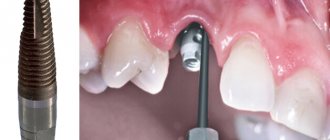After tooth extraction, the state of the dental system changes, the chewing load is redistributed, the bone tissue in the resulting gap is stabilized, and the hole is overgrown. All changes occur gradually, but over time the consequences manifest themselves in the form of bone atrophy, changes in the bite and subsidence of the gums. Is it possible to place an implant immediately after removal? Only an experienced specialist will answer the question, since it directly depends on the patient’s health condition. What implantation methods do modern dentistry offer and when can a dental implant be installed? Let's take a closer look.
When can a dental implant be placed after tooth extraction?
There are several methods for installing dental implants: two-stage, one-stage, one-stage. The latter is used immediately after tooth extraction. Its main difference is that the patient should have no contraindications for the operation, and the implantologist is fully prepared for the intended procedure. In practice, simultaneous implantation is rarely carried out, since most often they end up in the dentist’s chair too late, when the disease has progressed to an acute or chronic stage, severe pain has appeared and emergency removal is required. During a planned removal, the implantologist has from 2 to 14 days to prepare: collecting tests to identify contraindications, making casts of the jaw and a surgical template, selecting medications and creating a crown for the implant.
What is dental implantation under general anesthesia?
Until some time ago, operations during which dental implants were implanted were carried out using local anesthesia. This helped relieve patients from pain, but did not solve all the problems associated with the emotional state. Today, general anesthesia is widely used for these tasks. Thanks to this, patients who need dental implantation do not have to experience fear and discomfort during the operation.
Our modern dentistry in Moscow involves the use of general anesthesia, usually in situations where the installation of four or more implants is required. But, if there are medical indications, the doctor can use it to eliminate single defects in a number of teeth. At the same time, medications used for anesthesia have minimal impact on the patient’s health. In addition, when they are used, there is no accumulation of substances that are part of them in the body.
Pros and cons of implantation immediately after tooth extraction
Unlike classic removable prosthetics, a dental implant has many advantages: 1. Natural pressure is applied to the bone tissue, comparable to the load on your own tooth root. For this reason, atrophy does not progress, the process slows down, and when choosing high-quality implants, changes do not affect the gums for more than 5 years; 2. Reliable fixation of the prosthesis in the mouth allows you to eat your usual food and perform oral hygiene using conventional means; the prosthesis does not interfere with diction, feels like one’s own tooth, without changing the patient’s usual lifestyle; 3. You can chew with dental implants installed immediately after tooth extraction, after their complete healing, just like with your own teeth. In terms of reliability, they are not inferior to conventional implants installed using other methods; 4. When installing an implant on the day of removal, bone tissue augmentation is not required or is minimal (bone material is added to the tooth socket during the operation). This approach significantly saves time for more complex bone augmentation operations (can take from 3 to 6 months); 5. The patient needs to visit the dentist less, both for diagnosis and for surgery and subsequent monitoring. Time is saved for travel and doctor appointments without loss of quality; 6. Neighboring teeth are preserved, since implantation does not require additional supports or preparation of other teeth. In the long term, this will save teeth from falling out and destruction; 7. The service life of a dental implant is from 8 to 15 years if it belongs to the economy class segment, from 10 to 20 years in the middle segment, and premium class implants last more than 20 years. Removable dentures require adjustment and replacement on average every 5 years, while the reliability of the fit is less due to changes in bone tissue.
Proper planning
At the stage of preparation for removal, it is important to obtain maximum information about what is hidden under the gum - the number of roots, the direction of their growth, length, possible bends, etc. This data will help you plan the removal process correctly, which will ensure minimal trauma to the bone tissue. Therefore, the patient is first given:
- radiography,
- orthopantomography,
- tomography of the jaw.
How is the procedure done?
At the first stage, the patient visits the clinic for diagnostics. The blood is submitted to a laboratory for analysis; the analysis takes from one to several days. If you have your own diagnostic unit, the results can be known in a few hours. Afterwards an X-ray examination is carried out. To assess the condition of the jaw, a panoramic X-ray or computed tomography of the jaw is taken and the result is recorded on an information medium. If the patient goes to a third-party clinic or specialized center, the computed tomography scan is issued on a disk with the seal of the medical institution, signature and transcript of the specialist. Printing on film is rarely done, since electronic recording is more informative for the doctor. At the first appointment, the patient and dentist, having all the necessary data, discuss the expected result and which implantation options are most suitable for a particular patient. If during the examination no contraindications are identified, a treatment plan is drawn up that meets the patient’s wishes, then the dentist proceeds to the preparation stage.
In order for dental implantation to be successful immediately after removal, the dentist uses a computer model to predict the outcome of the operation. On the appointed day, the patient’s tooth is removed under anesthesia. An implant is placed in the socket, powdered bone material is added if necessary, and sutures are placed to close the operated area and stabilize the implant.
It is impossible to put a full load on an artificial tooth immediately after implantation, since primary stability can be disrupted. It is recommended not to overheat, hypothermia or physically overexert in the first week after surgery. In the first two months, it is recommended to follow a diet. Eat foods rich in vitamins and minerals, not spicy, salty or sour, as such foods irritate the mucous membrane.
The engraftment process takes from 4 to 6 months. After this time, the dentist will schedule a visit to determine the condition of the implant. When healing is complete, the crown is replaced. If the immediate loading technique was used, then initially a plastic crown is installed on the implant. This material is lighter and more aesthetic, and does not load the implant. But after six months of wearing it, it must be changed to ceramics, metal ceramics or zirconium. If a delayed loading protocol is used, a permanent crown is placed. It is fixed to the implant using an abutment after engraftment. The orthopedic stage completes the implantation process, after which the patient can chew and eat familiar foods.
After all procedures are completed, the patient must visit the dentist twice a year. This is necessary to preserve the implant and maintain stable oral health. During preventive examinations, the patient is recommended to undergo a hygienic teeth cleaning procedure. The plaque that forms in the oral cavity cannot be cleaned with a regular brush, even if all hygiene rules are followed. Professional cleaning helps prevent the accumulation of hard plaque around the implant, removes the yellow bacterial film, makes teeth naturally white, and eliminates microbes that cause gum inflammation. Gum disease directly affects the condition of the implant; in weakened gums, it becomes loose and falls out. Ultrasound cleaning reduces the risk of developing any periodontal diseases and improves the condition of teeth and gums.
Advantages of dental implantation under general anesthesia
One of the main advantages of implantation using general anesthesia is that it becomes possible to create the most comfortable conditions for a person who has decided to treat teeth with surgery.
At the same time, the procedure makes it possible to simultaneously solve other problems that are associated with dental treatment. The advantages of this type of anesthesia also include a significant reduction in time expenditure, since the volume of therapeutic manipulations, which are designed to last several weeks, can be done in one visit to the dentist.
Indications and restrictions
Single-stage implantation is suitable when it is necessary to remove mobile teeth destroyed by caries or as a result of trauma. It is used in protocols for single restorations, multiple and complete restoration of teeth.
But for implantation with a guarantee, the following conditions must be met:
- Preliminary planning and diagnostics are required. For emergency removals without examination, the technique is not used, since it is not possible to assess the conditions of a one-time installation.
- There should be no inflammatory processes on the roots of the teeth. If cysts or granulomas are detected, immediate implantation is not suitable. Installation of a sterile implant into purulent bone is fraught with complications.
- Tooth extraction must be atraumatic. For reliable fixation of the implant, it is important to preserve the alveolar process and bone walls and not damage them during removal.
- There should be no general contraindications. If obstacles to surgical intervention are detected, the health condition must first be adjusted.
Indications for dental implantation under general anesthesia
Dental prosthetics using general anesthesia is used in the following situations:
· the need to install a large number (more than 4) teeth at one time;
· the patient’s age is less than three years;
Allergy to local painkillers;
· severe fear of pain;
· low “pain threshold”;
· the occurrence of a gag reflex during dental treatment.
View treatment results
On the day of implantation.
- On the day of implantation, you need to eat 2 hours before the procedure, but not very dense or heavy food. Just as you can’t do implantation on an empty stomach, you shouldn’t overeat before surgery. You can drink water immediately before the operation.
- You need to thoroughly brush your teeth before the procedure.
- You need to choose clothes that are comfortable and do not cause any oppressive sensations.
- Do not drive a vehicle immediately after the operation. Arrange with someone close to you so that you can take them or use a taxi.
You can learn more about the restrictions for dental implantation HERE.
For more information and to make an appointment with a specialist, call:
+7,
Features of preparation for surgery
The preparatory stage is mandatory to identify contraindications, possible obstacles to implantation and eliminate risks
- X-ray diagnostics A targeted X-ray is carried out (determines the condition of 1-3 teeth) and computed tomography (reveals hidden problems - cyst, granuloma, periodontitis, inflammation at the root).
- Sanitation of the oral cavity is necessary to create sterility in the oral cavity to avoid infection of the surgical wound. If there is dense plaque and stone, hygienic cleaning is carried out. Neighboring teeth are treated for caries.
- Tests are prescribed to patients with general somatic diseases to identify factors that impede surgery. If obstacles are detected, the health status is adjusted by a specialized specialist.
Thanks to clear planning and adherence to protocol, the operation has a predictable outcome
Stages of one-stage implantation
The operation is performed under local anesthesia or sedation and lasts no longer than half an hour.
- Tooth extraction is performed using an ultrasonic scalpel according to the PiezoSurgery® protocol extremely carefully so as not to damage the alveolar ridge.
- Implant installation It is installed in place of the extracted tooth. If the hole is wider than the diameter of the implant, bone chips are added.
- Prosthetics In certain conditions, immediate loading with a temporary crown on the day of implantation is possible.
Operations in our Center are performed only by maxillofacial surgeons and implantologists with continuous experience of at least 5 years . These are thoughtful specialists with sufficient theoretical and practical skills, excellent clinical thinking and refined manual skills.
After the operation, we provide a free set of medications to relieve pain and prevent inflammation. The package also contains instructions with rules of conduct during the rehabilitation period. Please do not skip taking medications and follow the recommendations to avoid complications.
BozhkovRoman Andreevich
Implant surgeon, 13 years of experience
Nobel Biocare Certified Specialist
Leading specialist of the Center for high-complexity implantation. Gently removes teeth using ultrasound according to the PiezoSurgery® protocol. Nobel Biocare® Clinical Expert.
More about the doctor











